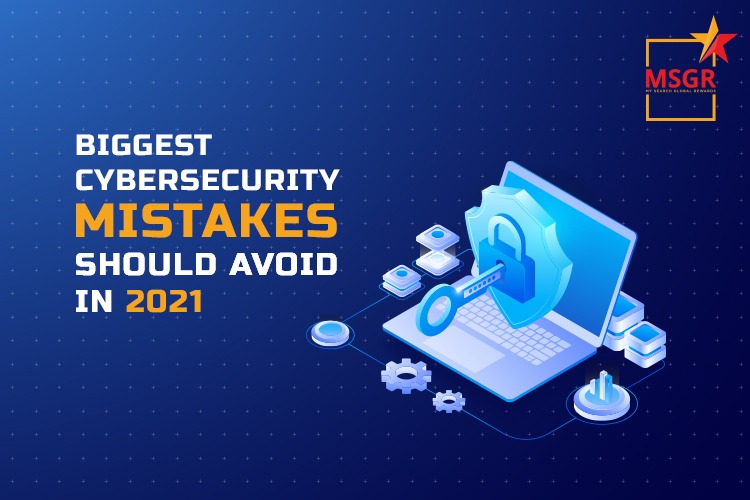Biggest Cybersecurity Mistakes Companies Should Avoid in 2021 The pandemic has forced us to adapt our working methods, and 2021 will be no different. As a result of the expansion of digital transformation and remote workplaces employing cloud-based platforms, cybersecurity concerns have greatly increased. Cybersecurity should be a top priority for businesses. In 2020, 95% of cybersecurity violations are committed by individuals within the company.We can reduce risks in 2021 by avoiding these five frequent cybersecurity mistakes. 1. Mistake - Assuming you can’t be a target Cyber-attacks are a threat to any firm that operates online. Just because your firm doesn't handle sensitive data like credit card numbers or personally identifying information doesn't mean it won't be targeted by hackers. Adversaries are constantly trying to break into the network in order to steal whatever valuable data and assets they can. Solution : Preventive measures and awareness can go a long way toward securing and maintaining your online presence. Leaders must make cybersecurity a top priority for their company by recruiting experienced professionals to conduct frequent evaluations and tests. This aids in the detection of flaws in the technology and processes. 2. Mistake - Approaching security as just an IT issue Companies must secure not only personally identifiable information (PII), but also intellectual property, trade secrets, research and development, and other sensitive data.Cybersecurity assaults have a negative impact on a company's bottom line, financial situation, reputation, and operations, therefore having clear policies and procedures in place may help companies and their employees respond more efficiently. Solution : The company's cyber risk should be raised to the highest echelons of the decision-making body on a regular basis, including board members. While corporate leaders are not necessary to understand technical intricacies, they must have sufficient threat awareness to assist in the formulation of acceptable cyber-response plans and the allocation of appropriate resources to carry them out. Through training, education, and simulations, teach the whole company—from the top down—how to recognise risks, prevent assaults, and recover from them. 3. Mistake - Neglecting to comprehend and update your network Companies will never be able to prevent every assault; networks and target spaces are far too vast, and there are far too many ways in. Neglecting to comprehend your network's design and maintain your software up to date,on the other hand, allows an opponent to break into your system with little to no resistance. Solution: The IT team at the enterprise level must establish stringent guidelines to ensure that all software is updated on a regular basis. The company must know where its vital data is stored, how large the network is, where the egress points are located, and how the network is split.The company is put at unnecessary peril due to a lack of grasp of basic network principles and customary "network hygiene." Maintain a sense of urgency and complete the task. 4. Mistake - Relying solely on anti-virus technologies Anti-virus solutions alone are incapable of combating persistent and complex attacks in today's complex threat landscape. Security businesses are struggling to keep up with the evolution of adversaries' tradecraft. The situation is exacerbated by the fact that attackers are increasingly employing malware-free access methods.In fact, malware is used in less than 40% of today's attacks. To keep the organisation safe, you can't rely solely on perimeter security. Solution: Antivirus software is still useful and must be updated on a regular basis. Responding exclusively to threats that have already been detected, on the other hand, is like being a bank guard who allows a robber in because the authorities haven't issued a robbery suspect's description yet. A smart bank guard learns to remain on the lookout for suspicious activity in any location. Traditional antivirus software may identify common malware, but it's no match for sophisticated attackers using stealthy entry techniques. Even if there are no recognised signatures, organisations must utilise solutions that identify adversary aims and attack impacts. 5. Mistake - Failing to monitor your enterprise endpoints The traditional “defense-in-depth” paradigm has focused on guarding an organization's perimeter. Adversaries are increasingly exploring ways to enter networks and execute code at the system's endpoints. In addition, we're also witnessing a continual and ever-evolving complexity in opponent tradecraft that we haven't seen before. Keeping an eye on the peripheral is the only way to achieve "silent failure". That is, once an adversary enters, he is free to work without fear of being discovered because no one is looking. He'll operate with complete impunity, putting your company in significant peril. Solution:Use technology that continuously monitors endpoints. Endpoint visibility is essential for moving from reactive to proactive security hunting and detection. Aggregating vast amounts of data and looking for unusual activity across the company will aid in the detection of attack indications. You can isolate and reduce the attackers' influence on your network if you can quickly identify adversary activity. Cybersecurity is a major problem that should not be overlooked. Hopefully, you'll be able to gain some useful insight into what might happen if you ignore your security, as well as how to avoid it.
Blogs
Reshma P
Biggest Cyber-security Mistakes Companies Should Avoid in 2021
29 Jun 2021

Read More





